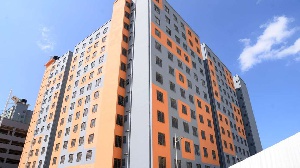 The completed Affordable Housing project in Ngara along Park Road, Nairobi.
The completed Affordable Housing project in Ngara along Park Road, Nairobi.
Primary school teacher William Malalo dreams of becoming the first in his family to own a home.
The 45-year-old father of three was born and raised in Kawangware, a sprawling, low-income city estate in Kenya's capital Nairobi. He has rented small and often badly built and poorly serviced accommodation in the same neighborhood his entire life, paying too much for too little.
“It is painful to pay rent all these years, yet the house can never be yours,” he says, his voice cracking.
The part-time pastor is among the 90 percent of households in Nairobi who rent. And he is now pinning his dreams of home ownership on the Park Road project, a series of apartment blocks being built under Kenyan government’s affordable housing programme.
Malalo has tucked away savings to meet the 12.5 percent minimum contribution needed to qualify for a three-bedroom apartment that costs Ksh4 million (about $40,000), a place he is eager to call home.
More than 300,000 Kenyans have already signed up on the government’s online portal to buy one of only 1,370 Park Road units. At the site in Ngara, about 3km north of Nairobi, the rumble of equipment and loaded trucks rents the air as construction of a few remaining blocks enters homestretch.
Priority will be given to those formerly living in the 48 derelict homes on the site demolished to make way for the project. Still, despite the odds, Malalo remains optimistic.
High prices, expensive loans
The feverish demand for the Park Road apartments highlights the scale of Kenya’s affordable housing crunch, estimated at two million units, with the deficit growing by 150,000 units annually, according to a World Bank Group study.
For Malalo and millions of others like him, high prices and expensive loans have long kept the dream of home ownership out of reach.
The housing crunch is not unique to Kenya. Uganda suffers a deficit of 2.1 million housing units, with the gap growing by 200,000 units a year, according to the country’s bureau of statistics. In Tanzania, housing shortage is about three million units.
The government has made affordable housing part of its Big 4 development agenda, alongside enhancing manufacturing, improving food security, and achieving universal health coverage.
What is ‘affordable’ is open to debate. Usually assumed to be no more than 30 per cent of monthly income, home affordability essentially comes down to household income, the price of the house, and finance repayment terms (interest rate and tenor).
Kenya’s Housing and Urban Development Principal Secretary Charles Hinga said the government has identified four main factors pushing up prices: Cost of land; unaffordable credit and financing rates; lengthy property registration and transfer times; and the cost of construction and construction materials.
Kenya worked from the ground up, literally, by tackling the cost of land and servicing expenses, including laying basic infrastructure like power lines, water, sewerage, and access roads.
The government holds thousands of acres of empty or underused public land across major towns. It decided to offer these plots to private investors to build modern, affordable housing on them.
“By offering land we have taken out 30-40 percent of costs of housing development, which translates to a steep price drop for end-users,” said Hinga.
Park Road is the pilot project for this strategy. Construction kicked off early 2019 across nine acres that hosted rickety, dilapidated houses for civil servants, and is now nearing completion. As a flagship government housing project, leveraging private sector’s expertise and capital, it is the blueprint for future low-cost residential units in major towns.
The Park Road apartments are about half the price of similar units in the area, according to a study by Centre for Affordable Housing Finance in Africa. They come equipped with solar water heaters, lifts, a rooftop garden, and a shared children’s playground.
Affordable mortgages
Reducing housing costs by targeting land costs solves only one part of Kenya’s complex housing puzzle, however.
With support from the World Bank and its private-sector investment arm International Finance Corporation (IFC), Kenyan officials sought a strategy to increase access to home loans. Short maturity terms and high interest rates have long discouraged even those on steady incomes from applying.
The Kenya Mortgage Refinance Company was recently formed to help address these problems.
KMRC draws its shareholding from the government, commercial banks, savings and credit cooperative societies (Saccos), IFC, and Shelter Afrique, a pan-African housing finance institution.
Its role is to channel long-term funds raised from institutional investors, development partners, and the capital market into banks and Saccos for onward lending to home buyers.